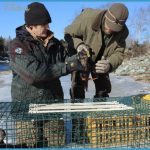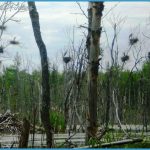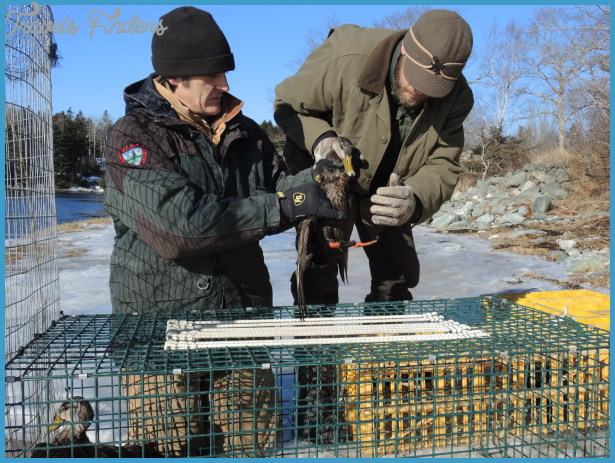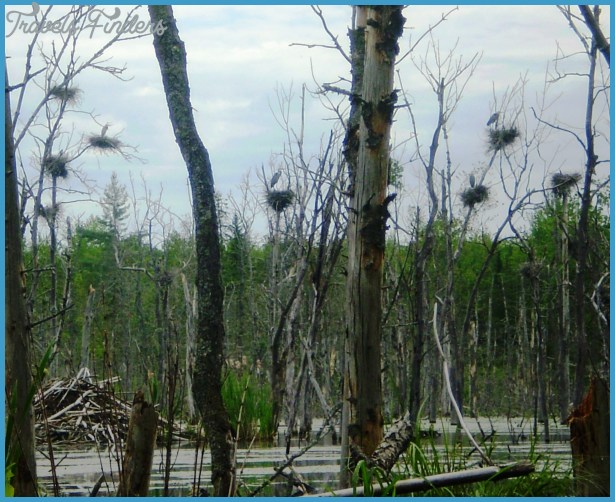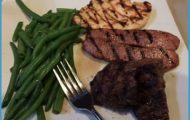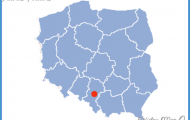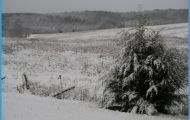Beavers are ubiquitous in Maine. Though sometimes cursed by landowners, the busy rodents are responsible for creating some fantastic, albeit shortlived brook trout fishing. When beavers dam a stream or brook, the resulting impoundment is called a “beaver flowage.” Any native brook trout living in the newly created pond is suddenly faced with an abundance of food and plenty of room to grow. Eventually, tannin leaching from decaying plants renders the water infertile, forcing the trout to move on.
Most beaver flowages are small, usually much less than 10 acres. The fish are easily caught and heavy fishing pressure can wipe out the population in a short time. That is why beaver flowages are such well-kept secrets. Ardent brook trout anglers search far and wide for new flowages, always hoping to strike it rich. And they never, never divulge the location of a prime flowage.
You can find your own personal brook trout haven if you are willing to expend enough time and energy. The hours of tramping through alder jungles will be forgotten when you first behold wild brook trout dimpling the surface of some remote flowage and realize that you are the only person who knows of its existence. Treat such flowages with respect, for they are special places. Penobscot, Piscataquis, Aroostook, and Washington counties are all worth exploring for flowages.
Techniques
Spin fishing – An ultralight spinning outfit is perfect for brook trout fishing. Use from 2- to 4-pound test lines, since the light line will not scare the fish as would a heavier line and you will be able to make longer casts. Most Maine anglers favor a one-piece rod simply because it is usually shorter than the two-piece types, making it easier to tote along brushy streams and brooks.
One of the best spinning lures for brook trout is shaped like a small minnow and is called a goldfish by several manufacturers. This lure is of a simple, basic design, but it is a real brook trout killer. Use this lure in streams or ponds. If fishing a stream, cast upstream and reel slowly as the spoon is carried downstream with the current. When fishing ponds, cast out as far as you can and let the spoon settle to the bottom. Reel in slowly, imparting action with the tip of your rod. This lure is especially good early in the season.
Small spinners such as the Mepps series are effective on brook trout. These are best used in streams and rivers. As with the goldfish lure, reel in slowly, allowing the current to take your spinner where it may. You may want to bend the barbs down on the hooks of your spinning lures to make it easier to release fish.
The Super-Duper is another old-time favorite of Maine brook trout anglers. This oddshaped lure is good for ponds, streams, and especially beaver flowages. Use the smallest, lightest Super-Duper you can find and fish it slowly.
Fly casting – Fly casting for brook trout is the most enjoyable and rewarding method of all. Unless you are fishing a big lake on a windy day, use the lightest rod you can find. A 7.5- or 8-foot, 3- to 5-weight rod is a pleasure to use and provides the most sport.
Brook trout are not terribly leader-shy, so a 9-foot leader with a 3-pound test tippet is about right for most situations. Brook trout are not usually as selective as brown trout, although at times they can drive you to the brink of frustration. While most brook trout are taken on underwater offerings, brookies do feed on the surface. Brook trout can also be ”pounded up” with attractor patterns such as the royal coachman and Adams. You should stock some caddis patterns, as well as dun variants and blue-winged olives in a variety of sizes. The best time to take brookies on dry flies is in the morning and evening hours. Brook trout sometimes feed on the surface during the day, especially in shaded sections of ponds and streams and on overcast or rainy days. If you are fishing with bucktails or nymphs from a boat or canoe, always keep a separate fly rod strung up with a dry-fly attractor pattern. That way, you will be ready to present a surface offering should surface activity commence.
Nymph fishers take their share of brookies too. Again, pattern is not especially important. The author has pared his nymph fishing down to one pattern, the soft-hackle fly. These simple flies, in various shades and sizes, are very effective on not only brook trout, but all salmonids. A sinking fly line, long leader, and 2- to 3-pound test tippet will round out your outfit.
Bucktails and streamers are popular brook-trout flies, with bucktails taking the edge in fish appeal. Bucktails, hair-wing flies tied on size 6, 8, and 10 hooks, are realistic minnow imitations. Popular patterns include red-and-white, Edson tiger light, Edson tiger dark, gray ghost, Jerry’s Smelt, any of the Thunder
Creek series, and muddler minnows.
Just after ice-out, bucktails can be used to take brook trout by trolling. Troll in a zig-zag pattern, not more than 50 feet from the shore. It is important that you go slow and impart plenty of action to your fly. Bucktails can be used in conjunction with dodgers to take brook trout. Use a 5- or 6-inch leader between the fly and the dodger.
Bait fishing – In early spring a can of earthworms, an ultralight spinning outfit, and a small stream spell brook trout fishing for many Maine anglers. At this time of year, trout are sluggish because of the influx of super-chilled water from snowmelt. Spring freshets wash earthworms and other land-based food forms into the trout’s habitat so the fish are attuned to feeding on worms. A meal of fresh brook trout, coupled with a plate of steamed fiddleheads (the immature fronds of the ostrich fern) is a rite of spring for Maine folk.
Using a size 8 or 10 barbless hook, lightly impale one or two earthworms so they dangle. Do not ball the worm up on the hook. If you must use a sinker, use only one size b.b. split shot, about 10 inches above the hook. Do not use a swivel or any other terminal gear.
You want your offering to appear as natural as possible. If fishing a brook or stream, cast upstream and let your offering float downstream. Keep your line tight enough to detect a take but don’t impart any artificial action.
You can fish ponds from the shore, using worms. Cast out and let your bait sink to the bottom. Slowly retrieve it in short increments. You might use two rods, letting one worm sit on the bottom while you slowly retrieve the other. In early spring, search for sandy bottom on the south side of a pond or lake. The trout will be here now, taking advantage of the warm mini-climate created by the sun’s rays.
Ice fishing – Brook trout are willing feeders in winter. Tip-ups, baited with small minnows or earthworms, are standard fare. Brook trout bite so well through the ice that many trout ponds are closed to ice-fishing. In general, trout bite best in the early part of the season.
Set your tip-ups out in no more than 20 feet of water. When you get a flag, make haste to attend your tip-up. Carefully watch the underwater spool for signs of movement but don’t pick it up until you are sure the fish has a solid hold on the bait. Any undue pressure before the fish is ready to be hooked will cause the fish to drop the bait and depart.
Best bets for Maine brook trout: Prestile Stream, Site 80; Moose River, Site 68; Rangeley Lake, Site 14; and Swan Lake, Site 31.

